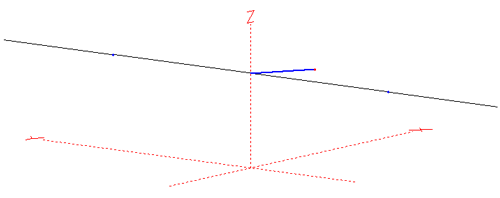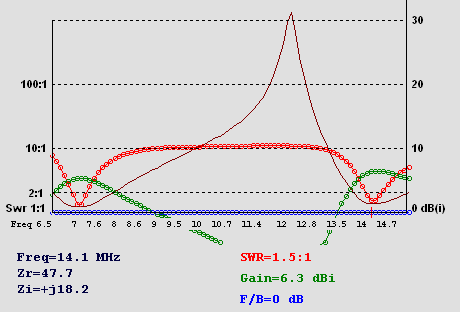Faster!

OK... that is looking much better!

OK... that is looking much better!
My friend Craig AA0ZZ was able to give me some valuable insight. I need to zoom into
quite a bit in the time domain to be able to see the sine wave otherwise it just looks
like blurred noise. Once you zoom into the time domain a bit you can see a nice oscillator
as you might expect.

Then I was able to right click and select the waveform (source data) to show
in the FFT display

I have to say that this looks pretty cool. There is a lot of magic in this application.
I have some other examples that I want to build to see how they look/work. I am such
an electronics newbie that this is all uncharted territory for me.
Here is an interesting little transmitter. I found it while searching for oscillator
information.
http://www.aa5tb.com/40mtx.html
http://www.aa5tb.com/40m_schem.html
Ok... Now I am seeing something that resembles RF from an oscillator.
I had to enable Small Signal AC Analysis.
Then I had to configure the AC Analysis Option
Now that I have some notes in the blog I can come back here to try to remember how
I made this work last time. :-)
Hmmm... my 40m oscillator from the example does not seem to be making noise where
I would expect it to.
It is clear that there is a lot here that I do not understand. :-)
I am trying to figure out how to use LTSpice. Craig AA0ZZ provided an oscillator model
to use as an example.

Here is an interesting PDF that I found that provides some initial hints on using
the tool:
http://pages.suddenlink.net/wa5bdu/ltguide.pdf
Drawing the schematics are pretty easy for anyone that has used a CAD program or something
like Visio. Being able to see RF is quite a bit more challenging.

I have LTSpice running under Wine on an Ubuntu 8.10 VM guest.
I am at home with my kids for spring break. I have managed to have the radio in the
shack turned on quite a bit. I have been trying to make a point of putting a few q's
into the log on a more regular basis. Here a couple of them that I have worked in
the past 24 hours or so.

My two older sons thought that it was kind of neat to work people in Russia and Japan.
It does not mean much to them yet other than an interesting voice or some dits and
dahs from 1/2 way around the world.
The Europeans were getting ready for a contest this weekend. Lots of interesting callsigns
emitting RF
I am starting to think about my options for antennas for Field Day 2009. I will be
camping @ Monson Lake State Park, MN. I will be operating QRP in class 1B1B. (K2 +
battery @ 5w) I would like to have 2 antennas that will cover 20/40/80 and fit
within a modest size campsite.
There are lots of simple options for 20/40 with wire dipoles. 80m becomes a challenge
because of the size of the antenna @ a 1/4 wave length. I will need to try to check
out the campsite ahead of time to see if a 1/4 wave dipole is an option. Assuming
that I need to go with a plan option for 80m I have an idea for that as well.
20m/40m Dipole Idea
KD1JV inspired 20/40 antenna with some tweaks.
---Trap-----Center-----Trap----
Center to Trap = 16.363'
Trap to End = 13'
Trap is a T50-2 with 24 turns or 2.8uH + a 47pF cap across the core.
A T50-6 with 26 turns or a FT50-61 with 6 turns would also work.
Tuned for 7.05 mhz and 14.05 mhz @ 50 ohm
The 20/40 antenna is modeled @ 30' of elevation. The SWR will drop a bit more as the
elevation increases. 30'-40' is a pretty good comprise height for this antenna.
--------------------
80m Antenna Idea
80m inverted L with an elevated radial @ 75 ohm
The base is elevated 6' above the ground.
The elevated radial is 10' long.
The vertical section of the antenna is 30' tall (top of the vertical section is @
36')
The top hat wire is 37.5 feet long.

The natural feed point is SWR 1713:1 or Zr/Zi = 20.3, -j1613
Given the ugly feed point values there are some easy options to get a match.
I have chosen two different L networks options because of their ease of construction
and semi-achievable parts. (Almost anything is possible in a model... but
in the real world Mr. Murphy general has some harsh reality checks for us.)
Option 1 for 75 ohm coax
C-L Lo Pass L-Net
Shunt: 782.43 pF, Series: 73.96 uH, Q=225
73.96 uH = 13 turns on a FT50-43
Option 2 for 75 ohm coax
C-L Hi Pass L-Net
Series: 18.2 pF, Shunt: 43.73 uH, Q=225
43.73uH = 10 turns on a FT50-43
There is a lot of room for improvement in the 80m model. For 30 minutes of modeling
it seemed like a decent start.
I happen to have some toroid cores, some variable capacitors, and some door knob capacitors
so these are all values with in reach of my work bench collection of parts. In case
you are wondering why some of the models have a 75 ohm feed point... 75 ohm coax is
cheap. We are talking about pennies per foot for RG6 which I happen to have a few
hundred of feet on a spool near by.
OK... in reality the 80m inverted L will suck. It
is too narrow and tweaky. It was a fun exercise... but I need something more realistic.
(An 80m dipole takes a LOT of space. Space & efficiency is what I am
competing against. I need to visit my campsite ahead of time to see how much
space I have to work with.)
Kind of a wild idea... turn on the radios, connect the coax, and make a couple of
contacts.
T77C 14.022mhz CW
5N0OCH 14.016mhz CW
P40YL 14.081mhz RTTY
These were made on my Icom 756 @ 100. (The K2 is listening to 30m at the moment.)
OK... back to the bench in the over room. I am working on building a direct conversion
80m CW rig.